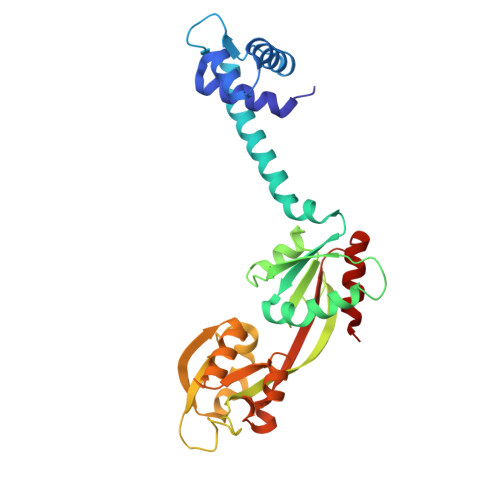Crystal structure details of Vibrio fischeri DarR and mutant DarR-M202I from LTTR family reveals their activation mechanism.
Wang, W., Wu, H., Xiao, Q., Zhou, H., Li, M., Xu, Q., Wang, Q., Yu, F., He, J.(2021) Int J Biol Macromol 183: 2354-2363
- PubMed: 34081954
- DOI: https://doi.org/10.1016/j.ijbiomac.2021.05.186
- Primary Citation of Related Structures:
7DWN, 7DWO - PubMed Abstract:
DarR, a novel member of the LTTR family derived from Vibrio fischeri, activates transcription in response to d-Asp and regulates the overexpression of the racD genes encoding a putative aspartate racemase, RacD. Here, the crystal structure of full-length DarR and its mutant DarR-M202I were obtained by X-ray crystallography. According to the electron density map analysis of full-length DarR, the effector binding site of DarR is occupied by 2-Morpholinoethanesulfonic acid monohydrate (MES), which could interact with amino acids in the effector binding site and stabilize the effector binding site. Furthermore, we elaborated the structure of DarR-M202I, where methionine is replaced by isoleucine resulting in overexpression of the downstream operon. By comparing DarR-MES and DarR-M202I, we found similar behavior of DarR-MES in terms of the stability of the RD active pocket and the deflection angle of the DBD. The Isothermal titration calorimetry and Gel-filtration chromatography experiments showed that only when the target DNA sequence of a particular quasi-palindromic sequence exceeds 19 bp, DarR can effectively bind to racD promoter. This study will help enhance our understanding of the mechanism in the transcriptional regulation of LTTR family transcription factors.
Organizational Affiliation:
Shanghai Institute of Applied Physics, Chinese Academy of Sciences, Shanghai 201800, China; University of Chinese Academy of Sciences, Beijing 100049, China.















